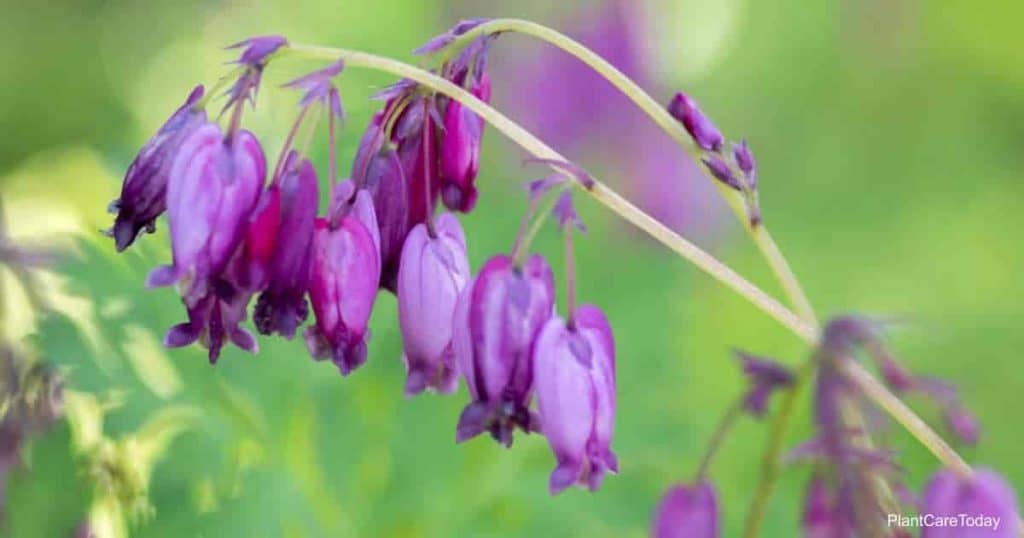Dicentra eximia [dy-SEN-truh, eks-IM-mee-uh] is a flowering fern-like plant belonging to the Papaveraceae family and native to the Appalachian Mountains.
The oddly-shaped flowers on the plant are the reason why it is popular among gardeners.

Some of the plant’s common names include:
- Fringed bleeding-heart
- Wild bleeding-heart
- Turkey-corn
- Plume bleeding-heart
Both the common name fringed bleeding-heart, and scientific name is about the flowers.
The specific epithet of the botanical name means a distinguished or unique two-spurred flower.
Learn more about Dicentra spectablis – the other Bleeding Heart Bush
Dicentra Eximia Care
Size & Growth
The plant has a comparatively slower growth rate and takes a while to reach its mature size.
When grown in favorable conditions, the plant grows up to 18” inches in height.
The green basal leaves and flower stems grow right off the scaly rootstock.
The foliage consists of light-green fern-like leaves, decorated with drooping heart-shaped flower clusters.
Eximia Flowering and Fragrance
The flowers produced are the plant’s its pride and glory.
They are the reason why gardening enthusiasts choose to use them in gardens and hedges around their homes.
When all growing conditions are met, and the weather is pleasant, the plant blooms in late spring and continues throughout the summer.
In hotter climates, the bloom period may be shorter.
The flowers are unique in the color pink. They appear in tight clusters atop fleshy stems above the leaves.
Each flower has four petals that are attached to a base.
The outer two petals are pouched at the base and bent back.
The inner petals, on the other hand, are perpendicular and connected at the tips.
Light & Temperature
The plants are hardy to USDA zones 3 to 9, which means eximia prefers lower temperatures and flowers profusely in colder summers.
In hotter conditions, flowering may be reduced, or plants may become completely dormant.
In its native habitat, the Dicentra plants grow on forest floors, rocky woods, and ledges. Where it thrives in part shade.
Direct sunlight for short periods may be tolerated, but partly shaded locations are more suitable for a healthy fringed bleeding-heart.
Watering and Feeding
The plants have medium watering needs and doesn’t require very frequent watering.
Be careful during the summer, especially if the weather is significantly hot. Eximia doesn’t respond well to dry soil. Never allow the soil to dry out.
In winters, space out the watering, so the soil doesn’t remain wet conditions for long periods.
Before watering, check the soil to make sure it’s not too moist.
Soil & Transplanting
The plant thrives in rich, moist soil with good drainage.
The soil should be loose enough to hold moisture but not remain damp.
In summers, eximia does not tolerant of dry soils. Make sure you water regularly to sustain moisture levels.
Choose a humusy, sandy, or clay soil with relatively high fertility.
As for pH, mildly acidic to neutral soils will do just fine for fringed bleeding-hearts.
Fringed bleeding-hearts are not easy to transplant. They dislike established roots being disturbed and require a lot of attention to keep them healthy in a new spot.
This is why transplanting is best avoided.
If you must transplant, choose a location where all growing conditions are met and move the plant gently once the Dicentra goes dormant in the fall or spring before new shoots start emerging.
Grooming and Maintenance
Fortunately, the fringed bleeding-heart plant is very low maintenance.
You do not need to spend a lot of time and energy, keeping up with the growth of the foliage.
How To Propagate Dicentra
One good thing about fringed bleeding heart is it self-seeds. This makes keeping up with its growth easy.
Propagate a plant yourself in two ways i.e., with seeds and with root division.
When propagating with seeds:
- Collect them before they ripen in the pods and store in refrigerated containers.
- After four weeks of cold stratification, sow them in spring once the last frost has passed.
Root division is done in spring or early fall.
This way of propagation is faster and produces the plant’s population rapidly.
Be very careful when transplanting the root divisions.
Established roots don’t like to be disturbed, so make sure you transplant the new shoots in their permanent position as soon as possible.
Wild Bleeding Heart Pest or Diseases
Dicentra is free of the most serious pest and disease issues.
There is some susceptibility to aphid attacks and infestations.
Fortunately, these are easy to get rid of.
Consult with a local garden center or nursery to find a solution and use the least toxic one. Check out our favorite natural solutions for pest control.
The plant does have toxicity, as all its parts are poisonous.
- Contact with the leaves, roots, or stem without a barrier may irritate the skin and cause dermatitis.
- Ingesting any part of the plant in large quantities can lead to skin issues.
- It may also cause symptoms such as trembling, labored breathing, and an upset stomach.
- The toxicity of the plant comes from several isoquinoline alkaloids contained in the cell sap.
For more read our article on the Poisonous Bleeding Heart Plant
Uses For Dicentra
The heart-shaped flowers of the Dicentra species are it’s glory.
Their unique appearance and the bright coloring look spectacular when planted among other flowering species.
The garden uses for these plants are plenty and wide.
Dicentra are used in shaded borders along with houses and walkways.
Other uses include planting fringed bleeding heart with other flowering perennials in rock gardens, woodland gardens, wildflower gardens, and naturalized areas.